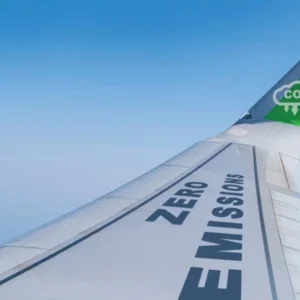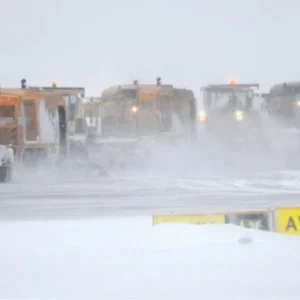
The rules and regulations that govern our skies may seem as ethereal as the air itself to the average traveller and yet, without them, safe air travel would be impossible. While these rules have remained largely the same since they were first implemented decades ago, recent technological advancements have enabled air traffic controllers in the UK to implement a new system to manage flight paths.
On 2 December 2021, NATS – the UK’s leading provider of air traffic control services – implemented the biggest ever airspace change undertaken in its history by introducing free route airspace (FRA) for the first time in British skies. This involved removing traditional airspace structures above 25,500ft, allowing airlines to plan and fly their preferred route between a defined entry and exit point. It gives aircraft greater flexibility when determining their optimal flight plan, enabling pilots to take factors such as weather and wind speed into account when up in the air.
NATS had been developing FRA for over five years – prior to this the level of flexibility FRA provides had not been possible. The previous airspace structure requiring aircraft to follow predefined routes – something that Lee Boulton, head of airspace development at NATS, likens to “motorways in the sky”, with set points of intersections between routes where aircraft could potentially cross to other paths and interact with a different route. Now, thanks to new technology and navigational techniques, along with cross-border collaboration, FRA can help make flying at high levels of altitude much more efficient – reducing cost, fuel burn, flight time and CO2 emissions.
“Most importantly, [FRA] offers the benefits of quicker and cleaner journeys through UK airspace,” Boulton notes. “Ultimately, modernising our airspace is all about delivering these benefits – it all adds up to a far more efficient way to fly.
The northern flights
FRA removed long-established routes in the airspace over the North Sea, Scotland, North Atlantic, Northern Ireland and a small portion of northern England – covering approximately 150,000m2. This area accounts for roughly one-third of UK airspace and is over twice the size of the UK itself – it can see up to 2,000 flights a day and covers around 80% of all transatlantic flights. The current area covered by FRA is managed through the Prestwick Centre on the west coast of Scotland, some 30 miles south-west of Glasgow. FRA covers eight operational sectors – a sector being the defined area within which a controller operates, enabling airspace to be divided up in a safe and efficient way.
However, FRA does not apply to all of the sky managed by Prestwick Centre. Specifically, it is currently tied to airspace above a single defined flight level – Flight Level 255 (25,500ft and above) – for a number of reasons. “It’s not possible to do implement FRA at lower levels of our airspace, because of the complexity of aircraft arriving and departing from multiple airports,” explains Boulton. “There has to be an element of planning and order where all these flights are positioned for arrival to, or departure from, one or more airports.”
In the upper airspace, however, NATS has systems in place that enable its air traffic controllers to identify the trajectories of aircraft well in advance and can highlight the conflicts that may occur from aircraft flight paths intersecting, enabling controllers to plan early and ensure all aircraft using the airspace remain correctly and safely separated.
“That’s where the systems are vital – to enable the controllers to pinpoint these conflicts and resolve them and make sure that the aeroplanes operate safely,” says Boulton. “In time, we’ll see that same type of technology implemented in the lower air space. But that’s not for many years yet.”
An environmental achievement
FRA is just one of many changes that NATS will implement to help the UK aviation industry achieve a 15% reduction of its 2019 carbon emissions by 2030. By 2040, NATS is aiming to reach a 40% reduction, with the ultimate goal for the industry of net-zero by 2050. While new aircraft and engine technologies hold the greatest potential for CO2 savings, alongside sustainable aviation fuels, they are still some years away. As a result, maximising airspace efficiency could play a major role in reducing the industry’s environmental impact, and it is a step that is being taken right now. FRA over the north of the UK is forecasted to deliver 12,000t of CO2 reduction per year – roughly equivalent to the carbon footprint of 3,500 family homes, according to Boulton.
“Over the period of a year, [FRA] would save 500,000 nautical miles of flight in terms of distance, which is obviously significant,” he adds. “It’s equivalent to about 30 flights per day between London and Scotland, in terms of the reduction of CO2 emissions. That’s quite a significant contribution to our pathway to achieving net zero by 2050.”
The introduction of FRA in the north marks the first of four planned deployments across the UK over the next five years, and FRA should be fully implemented across the entirety of Europe by the end of 2027. The next area that will see FRA deployed will be over the west and south-west of the UK (FRA Deployment 2, as opposed to FRA Deployment 1 over the north). That change is on track to go into effect in March 2023, and will pair FRA above 24,500ft with systematisation to the lower network from 7,000ft up to 24,500ft.
The view from Europe
However, FRA is far from just a UK-only project. Indeed, it could easily be seen as a pan-European achievement in many ways, with NATS working closely alongside Europe’s governing bodies over the course of its development.
“As you can imagine, there’s an awful lot of collaboration across the industry to achieve these significant changes in the way that we operate our airspace,” says Boulton, referring to the work NATS has carried out alongside the Borealis Alliance – a coalition of air navigation service providers (ANSPs) from Ireland, the UK, Denmark, Estonia, Finland, Iceland, Latvia, Norway and Sweden. The group’s main focus is to deliver a seamless area of FRA across the entire area managed by its members, of which the FRA now in place over Scotland is but the first step in the UK. The reason behind this collaboration is not hard to see – as the area covered by FRA grows, so too do the benefits that come with it. Collaboration among ANSPs is vital for the successful roll-out of FRA across Europe, as air traffic control is, by its very nature, a highly collaborative process. The exchange of data between stakeholders is critical to the safe operation of air traffic – controllers need to know where aircraft are and where they are headed. So, when one group are looking to make changes to their part of the operation, the entire system needs to adapt around that change.
“We have a different system to the Irish, to the Danish, and there are different systems across Europe,” says Boulton. However, all stakeholders need to be able to transfer data in a standard way from one air traffic control system to another – which they do through the On-line Data Interchange. NATS had to find a way to adapt the interfaces between all these systems so that it could register and reflect FRA operations, rather than just the traditional set flight paths.
Safety first
There were plenty of other challenges during the FRA’s development, of course – with a change this wide-ranging and fundamental, maintaining operational safety was of the utmost importance. That can take time – controllers and support staff need to be retrained, and NATS also had to work with airlines, Eurocontrol and other ANSPs to ensure all stakeholders were up to speed. And, before any of this, NATS had to devise the rules to govern FRA and run simulations to ensure the new procedures could be safely implemented by its air traffic controllers.
Similarly, the pandemic was a significant challenge, emerging late in FRA’s development. December 2021 was the original timeline for deploying FRA, and NATS worked hard to maintain the course in the face of pandemic regulations and restrictions.
To overcome some of these obstacles, NATS found ways to allow controllers to work at a distance from one another – 137 controllers were able to go through simulation training during the height of Covid regulations. A further 425 later received briefings at Prestwick centre, where FRA was deployed, or at the London Area Control Centre (LACC) in Swanwick.
Ultimately, the Civil Aviation Authority (CAA) approved NATS’ airspace change proposal, which was a huge win for Boulton and his colleagues. FRA was successfully implemented on 21 December 2021, as planned. Work remains to be done as the introduction of the other phases of the UK’s FRA will coincide with the widespread resumption of air travel – the UK expects to see 90% of 2019 local traffic levels in 2022. Looking ahead, the International Air Transport Association (IATA) expects overall traveller numbers to exceed pre-pandemic levels by 2024, highlighting the environmental and operations benefits that FRA can provide. Managing the recovery alongside the upcoming FRA deployments will be a challenge for NATS, but one it is working hard to achieve.
150,000m2
The area covered by FRA in the north of the UK.
12,000t
The amount of CO2 reduction per year due to FRA over the north of the UK.
NATS
3,500
The number of family homes this reduction would be equivalent to, with regard to CO2 emissions.
NATS






